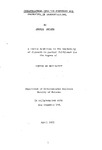INVESTIGATIONS INTO THE SYNTHESIS AND PROPERTIES OF INDENOPYRIDINES
| dc.contributor.author | SUGDEN, ANGELA | |
| dc.contributor.other | School of Geography, Earth and Environmental Sciences | en_US |
| dc.date.accessioned | 2013-09-13T09:55:41Z | |
| dc.date.available | 2013-09-13T09:55:41Z | |
| dc.date.issued | 1993 | |
| dc.identifier | NOT AVAILABLE | en_US |
| dc.identifier.uri | http://hdl.handle.net/10026.1/1685 | |
| dc.description.abstract |
Two novel routes have been investigated. Cyclisation of enamidoindenes by the Vilsmeier-Haack formylation was not possible because the condensation between indanones and acetamide, under acidic conditions, did not afford the desired monomer but instead two dimers, reported previously, were observed. The two routes by which these dimers maybe formed were thoroughly investigated and led to the synthesis of three novel compounds and a known compound, truxene. Omission of an acid catalyst afforded 2-acetamidoindene but not 1-acetamidoindene. Since commercial 2-indanone was found to be impure by TLC and melting point, a sample was synthesised using a literature method. Pure 2-indanone failed to react with acetamide. It seemed that 2-acetamidoindene was produced via an impurity in commercial 2-indanone and then only in poor yield. Attempts to identify the impurity were unsuccessful. The thermolytic Wolff rearrangement of benz[h]quinoline-5, 6-diazoketone to benzyl 5H-indeno[l, 2-b] pyridine-5-carboxylate initially proved promising. Many products were observed but none were isolated in sufficient purity for spectral characterisation. The photolytic Wolff rearrangement of 9-diazo-10-phenanthrone gave 9H-fluorene-9N-tertbutylcarboxamide whose physical properties, which were previously unknown, were recorded. Rearrangement of the pyridyl analogue appeared promising. Spectroscopic data indicated the desired products, but isolation of pure compounds was not achieved. Using a published synthesis, 5H-indeno[1,2-b]pyridin-5-one was made and reduction, by two separate methods, afforded the methylene compound. From these starting materials twenty-two novel compounds were made. For example, reduction of the ketone afforded the known alcohol (RS)5-hydroxy-5H-indeno [1,2-b] pyridine. Grignard reaction afforded the novel compound 5-hydroxy-5-phenylindeno [1,2-b] pyridine. The two substituted oximes, 5H-indeno [1,2- b] pyridin-5-one 2-chlorobenzyloxime and 2,4-dichlorobenzyloxime were prepared. Reduction of the known 5H-indeno [1,2-b] pyridin-5-one oxime afforded 5-acetamido-5H-indeno [1,2-b] pyridine . Substitution reactions afforded the known 7-bromo- and 7,9 - dibromo-5H-indeno [1,2-b] pyridin-5-one. Dibromo- and tribromo - 5H-indeno [1,2-b] pyridine were prepared, as confirmed by mass spectrometry. The novel 6,7,8,9-tetrabromo-5H-indeno [1,2-b] pyridine was obtained pure and fully characterised. The nitro-derivatives of the ketone and methylene compounds were prepared. Reduction of these compounds afforded the amino- derivatives which were diazotised to give the corresponding hydroxy-derivatives. Novel oximes of the 7-bromo- and 7-nitro-5H-indeno [1,2-b] pyridin-5-one derivatives were synthesized and then reduced to the corresponding 5-acetamido- derivatives. 7-nitro-5H-indeno[1,2-b] pyridin-5-one when reduced, gave the unexpected 5,7-diacetamido- derivative. 7-acetamido-5H-indeno [1,2-b) pyridin-5-one was also prepared. The known N-oxides of the ketone and methylene compounds were produced, as well as the novel N-oxides of the nitro-derivatives of 5H-indeno [1,2-b] pyridine-5-one and 5H-indeno [1,2-b] pyridine. From fluorene, 9-butyl, 9-propyl and 9-phenyl-9-hydroxyfluorene were prepared by Grignard reaction. Reduction of fluorenone using triethylsilane gave, unexpectedly, 9,9'-bifluorenyl. The structure s of known and novel compounds were confirmed by spectroscopic methods including ¹³C, ¹H NMR, infrared spectroscopy, mass spectrometry, melting point and TLC. | |
| dc.description.sponsorship | Key Organics Ltd. | en_US |
| dc.language.iso | en | en_US |
| dc.publisher | University of Plymouth | en_US |
| dc.title | INVESTIGATIONS INTO THE SYNTHESIS AND PROPERTIES OF INDENOPYRIDINES | en_US |
| dc.type | Thesis | |
| plymouth.version | Full version | en_US |
| dc.identifier.doi | http://dx.doi.org/10.24382/3847 | |
| dc.identifier.doi | http://dx.doi.org/10.24382/3847 |
Files in this item
This item appears in the following Collection(s)
-
01 Research Theses Main Collection
Research Theses Main


